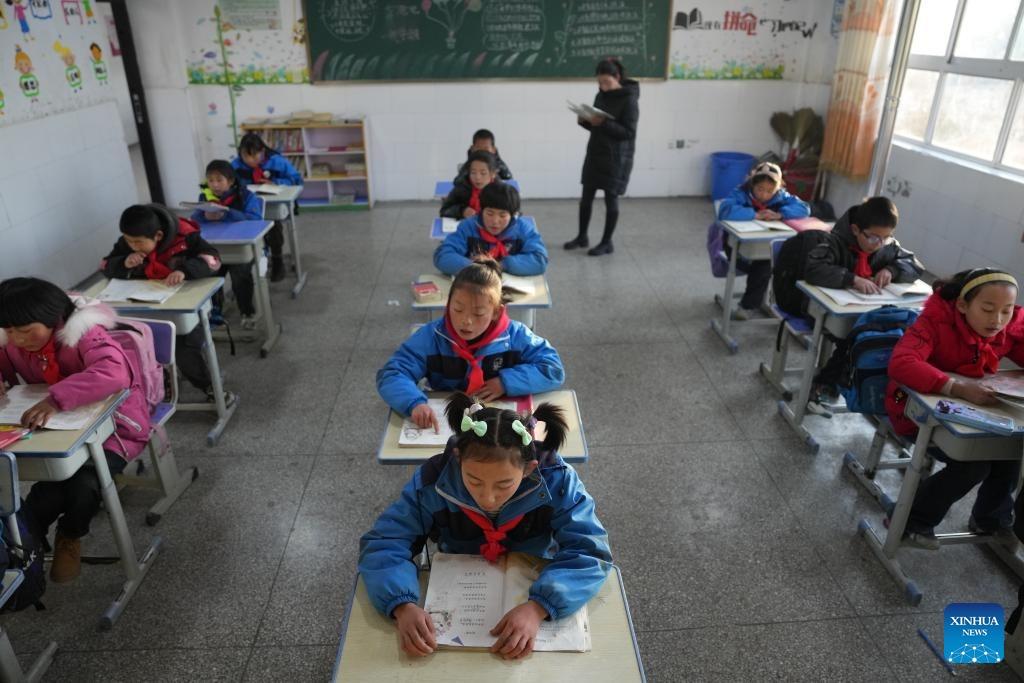Lawmakers call for close management to ensure quality education for students
 Students attend a class at a primary school in Liugou township of Jishishan county, northwest China's Gansu province, Dec 25, 2023. (PHOTO / XINHUA)
Students attend a class at a primary school in Liugou township of Jishishan county, northwest China's Gansu province, Dec 25, 2023. (PHOTO / XINHUA)
Lawmakers and political advisers have called for the better allocation of education resources in preparation for a drop in student numbers due to the country's declining birthrate.
They said while urban areas are likely to still have large numbers of students in the short term, they need to prepare for a sharp decline of school-aged children as the number of newborns has dropped significantly in the past several years.
However, they said the declining number of new births can offer schools the chance to reduce the size of each class and provide students with higher quality education.
There was an increase in births after China introduced the second-child policy in 2016, with 17.86 million recorded that year. However, according to the National Bureau of Statistics, the country only had 9.02 million births last year, down from 9.56 million in 2022.
Experts said the increase of newborns in 2016 and the significant drop in the last two years means schools need to prepare for a jump in the number of students, followed by an abrupt decline a few years later.
A notice issued by the Hunan Provincial Education Department in November asked local authorities to better allocate education resources for the next five to 10 years based on the birthrate, urbanization and the change in the number of school-aged children.
The province plans to build new public kindergartens in densely populated urban areas while no new kindergartens should be established in rural areas. It also encourages kindergartens with good conditions to offer daycare services to children 2 to 3 years old.
Qiao Jinzhong, an associate education professor at Beijing Normal University, projected that the number of students at primary and middle schools is likely to fall by 30 million from 2020 to 2035.
If the ratio of students and teachers remains unchanged, it means there will be a surplus of 1.5 million primary school teachers and 370,000 middle school teachers in 2035, he said.
A guideline issued by the Sichuan provincial education department and human resources and social security departments said the number of education majors at universities should be controlled to cope with the declining need for teachers in the future.
Ke Zhongming, a member of the 14th Guangzhou Committee of the Chinese People's Political Consultative Conference and a principal of a local primary school, said Guangzhou has spent a lot of resources to renovate and build new schools and hired lots of teachers in recent years, as China still has a large population, so the sheer demand for education resources will exist for a long time.
Moreover, the new teachers hired by the city have all received a good education, so they can improve the overall education quality in Guangzhou, he told local media Yangcheng Evening News.
Chen Wu, a deputy to the 16th Guangzhou people's congress and a local primary school principal, said on average there are 45 students per class at primary school and 50 students per class at middle school in the city.
With more investment in education and the declining number of students in the future, Guangzhou has the opportunity to gradually reduce the number of students in each class, so the students can receive more attention from teachers and have a more tailored education, he said.
Tianhe district, where Chen's school is located, has had a shortage in education resources during the past 10 years, and many schools have transformed the music rooms, art rooms and laboratories into classrooms to meet the demand, he said.
If the number of students decreases in the future, those rooms can be put to better use, so students can also receive better education, he added.
Wang Songsong contributed to this story.


